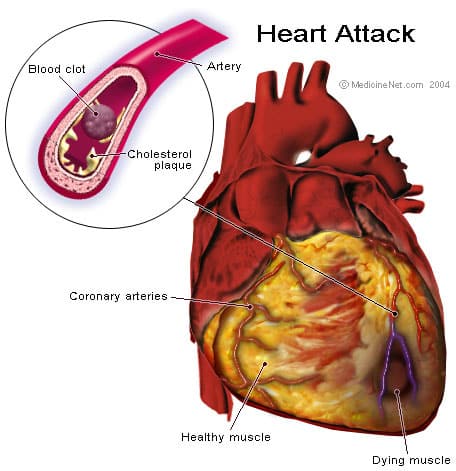Coronary artery disease is the single cause of death in developed countries. Coronary artery disease or CAD is responsible for about 20% of all deaths in America. This disease affects over 18 million people. Of these people, 10 million have chest pain, and 9 million have had a heart attack. The estimated cost of CAD is 170 billion dollars. This article will discuss Coronary Artery Disease: Overview, Symptoms, Causes, and Treatments.
Ischemic Heart Disease and Ischemic Heart Failure
Coronary artery disease is also called heart disease or atherosclerosis. It is caused by the build-up of fatty deposits plaque in the blood vessels of the heart. The heart must get oxygen and nutrients to working well.
Blood carries the oxygen and nutrients to the heart through the blood vessels called arteries.
As the plaque builds up in the blood vessels, blood flow to the heart muscle is decreased.
When blood flow is decreased, chest pain, shortness of breath, or other signs may occur. If the blood flow is stopped or blocked, it causes a heart attack.
Coronary artery disease can cause ischemic heart disease and ischemic heart failure. This is because if you have a heart attack secondary to plaque, the heart muscle can become weak. A weak heart muscle cannot pump effectively. This is when you will develop ischemic heart failure or ischemic heart disease.

Signs and Symptoms of Coronary Artery Disease and Ischemic Disease Symptoms
The first symptom of coronary artery disease is usually chest pain. Chest pain is experienced by at least 50% of people diagnosed with CAD. This is one of the main signs and symptoms.
This chest pain is caused by the obstruction of at least one large coronary artery. The pain is because the heart muscle is not getting any oxygen because of the blockage.
You may not have any signs or symptoms or you may have:
• Pain or pressure in your chest, arm, jaw, shoulders or neck also called angina. It may spread from one place to another. This pain may radiate to the jaw, shoulder, or arm. The symptoms are usually brought on by exertion, cold, emotional stress, or a heavy meal.
• Feeling of tightness, heaviness, pressure, squeezing or burning
• Sweating • Shortness of breath • Nausea or vomiting
• Abdominal pain
• If you are feeling very tired, dizzy or faint, Call 911 if you have any of these signs.
Coronary artery disease can cause arterial occlusive disease.
Arterial occlusive disease is where the aorta and other arteries become narrow because of a blockage of the opening of the artery.
The main arterial arteries are aorta, femoral, and brachial. So you can see that when these arteries are blocked, a person can have serious health problems.
In advanced arterial disease, the person might have an amputation, heart attacks, and strokes.
Artery disease in the legs can affect an individual ability to walk. These people also have a lot of swelling. This swelling can be minimized by using compression stockings such as YOLIX compression stockings or Hebe compression stockings.
What is Coronary Artery Disease: Risk Factors
You are at higher risk of getting coronary artery disease if you:
• Have a family history of the disease
• Have high cholesterol, diabetes or high blood pressure
• Smoke or use tobacco • Are inactive
• Stress
• Overweight – Changing even one risk factor can improve your heart health. You can prevent the disease from getting worse and may even help to improve it.
Coronary Artery Disease Symptoms: Your Care
Your Care If your doctor thinks that you have coronary artery disease, you may have tests such as:
• An electrocardiogram (ECG or EKG) to check the electrical activity of your heart.
• A cardiac magnetic resonance imaging test (MRI) to take pictures of how well your heart is working.
• A stress test to look for problems with your heart’s rate, rhythm or electrical activity. Blood pressure and signs such as shortness of breath or angina are also checked.
• An echocardiogram to see the size and shape of your heart and how well it is working.
• A chest x-ray to check your heart, blood vessels and lungs.
• Blood tests to check levels of fats, cholesterol, sugar, and proteins in your blood. If tests show that you are likely to have CAD, other tests or procedures may be done to treat the disease. The goal is to improve blood flow to your heart muscle and decrease your risk of a heart attack. Treatment may include:
• Medicines
• Exercise
• A low-fat diet
• Procedures or surgery
• A cardiac rehab program, n0 matter what type of treatment is done, does not “cure” the disease. You need to change your risk factors and follow your care plan.
Conclusion
Coronary artery disease is the leading cause of heart disease. Coronary heart disease can also cause ischaemic heart failure. However, the majority of coronary artery disease can be eliminated with lifestyle changes.





